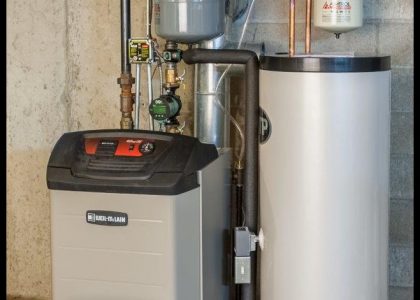You have doubtless noted the “Plumbing & Heating” Logos on Trade Vehicles. Both disciplines are related, specifically to FHW (Forced Hot Water – Hydronic) Heating Systems, but not necessarily synonymous. They share similar tools and some materials, but not the same techniques — and it shows!
At the risk of categorization and classification we can readily identify with surety who installed your heating system, i.e. a plumber, your brother-in-law, a DIY (Do-It-Yourselfer) or a heating specialist. The levels of knowledge, application skills and techniques define the end product, and its net performance and efficiency. To quote the axiom “the devil is in the detail” certainly applies to this observation and how the details affect system operation, efficiency and maintenance.
Ideally you want a FHW System that is finely tuned for performance, notably:
- The highest economically efficient energy producer (boiler)
- Hydronic components selected for operational efficiency and life cycle cost
- Circulation and radiation options complimenting your structure and lifestyle
- Complimentary, efficient DHW (Domestic Hot Water) Generation
- Optimized hydronic distribution (piping) and zoning
Prefacing our remarks, do not do a thing until you know your aggregate needs for heating energy! There is no excuse or recovery for not knowing this up front. A Heat Loss Calculator (see other blogs) is not outside the capability of a homeowner or DIY’er, not to mention the professional. Also the Calculator is a great tool for playing energy improvement scenarios prior to making money decisions. Git-er-done!
Boiler sizing is usually our first observed misapplication, virtually always too large for the current application. In fairness to the original installer and dating of an aging boiler, the existing structure and boiler inefficiencies were a factor as well, along with over-sizing practices at the time. Unfortunately the resultant of subsequent energy improvements and old indiscretions combine to make the boiler now substantially over-sized and an even greater stand-by loss energy robber. (See other blogs)
Additionally there are the “plumber’s boilers”, as called in the trade. Same so-so boiler, same techniques for decades. Even this “old dog” has had to learn some “new tricks”. The new Triple-Pass (Oil) and Condensing (Gas) Boilers offer us very efficient new tools — with new rules!
Near-Boiler Plumbing (includes the boiler and Distribution (Zone) piping) is the next focus area. Indicative poor practices are:
- Bushings in boiler supply and return outlets, reducing outlet piping sizes at the peril of high stress and corrosion prone fitting failures at the boiler. (We use Heavy Series Nipples and Reducing Elbows, Tees or Couplings to avoid this structural risk.) Such failures are so much fun!
- Continuously hard-piped (supply and return) manifolds, with too many fittings and no repair or boiler removal provisions. (More fun!)
- Extended length manifolds with high cantilevered loads (weights), sometimes anchored to the floor, wall(s) or overhead construction for support. (Here’s our Patented Compact Steel Hydronic Header that addresses this problem.)
- Poor (or no) manifold flow proportioning.
- Lowered return manifold and piping.
- Lots of copper piping vs. iron.
- Misplaced, excessive or insufficient valving.
- Circulation and/or Zone Valve application and placement.
The added Indirect Water Heater installation is virtually always “hacked”, i.e. however neatly installed it is thermally compromised. Too much, inappropriately sized, and somewhat under-insulated piping usually stretched from existing boiler manifolds contribute to unnecessary seasonal stand-by losses. (Our “Secret”: We “close-couple” Indirect Water Heaters directly to the first-off-the-boiler fittings to minimize heat loss. The system manifolds are unheated seasonally, save a little convective heating under the insulated riser piping.)
The guy who has to service a boiler knows best where to place service components (water pressure regulator, circulators, valving, relays, service switch or clean-out accesses)! We position all of ours within an arm’s reach for servicing efficiency.
A point to ponder: Every extra foot of piping, every elbow, foot of water head-height and gallon of water, through every fitting and valve consumes more energy to accomplish the heating task. Distribution efficiency is totally disregarded by every contemporary hydronic (FHW) heating system installer!
Example: A past “boiler swap” in an apartment house yielded an excess of 35 feet of copper pipe lengths, many shorter “cuts”, fittings, etc. The new Triple-Pass Weil-McLain Ultra Oil Boiler fires @ 70% of the prior 30 year older Weil with new, appropriate wet-rotor circulators uses 40% less fuel and supplies endless DHW through an 80 Gal. Indirect Water Heater. Every little bit counts — and counts up!
If it’s any consolation, many of the “old dog” plumbing guys are closing out their careers. Now we other “old dog” heating guys that are determined to continue adapting and applying our skills and experience using the new heating tools have our days in the sunlight. Problem is, we have a lot of consumer educating to do. Hope that jabbing our plumbing brothers a bit makes this ever more apparent.
To emphasize this point look at our “Neo-Gravity Hydronic (FHW) Heating Appliance” – U.S. Patented & Canada to follow) and our supporting Website.
If our fellow “Plumbing & Heating” Tradesmen need assistance in efficiently applying the latest in hydronic distribution technology, perhaps we can help them ….. or you, the consumer directly with “America’s Delta-T Hydronic (FHW) Heating Appliance(TM)”.
Updated 08/01/2018 P.D.M., Sr.

